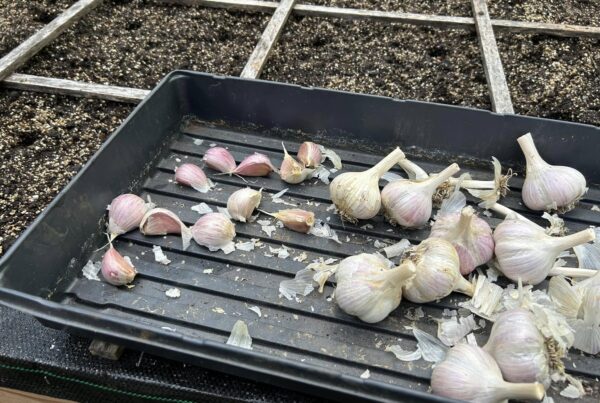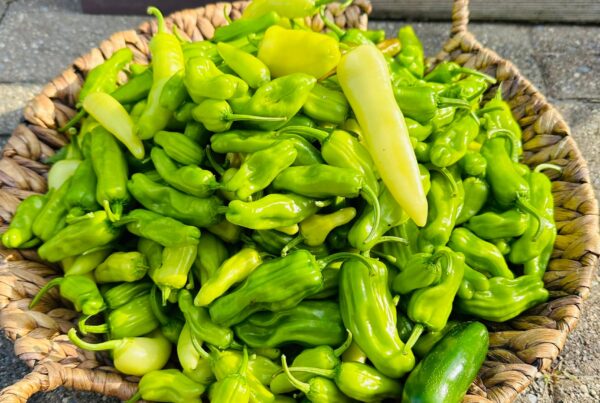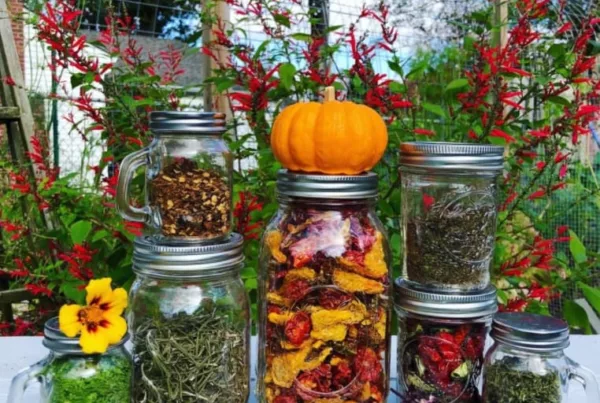Written by Kristina Hicks-Hamblin
It’s time to talk about dehydrating vegetables from your backyard garden. It’s a great method for food preservation, whether you have more than you can eat or just want to save the flavor for the chilly seasons. BTW, dehydrating your garden vegetables is incredibly safe — and easy too.
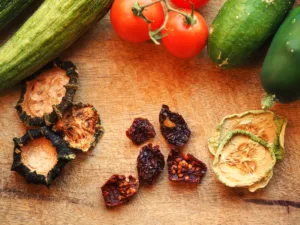
Zucchini, tomato, cucumber.
Dehydrating Vegetables – Which to Choose?
Before we get started on the techniques you’ll want to use, perhaps you are wondering which types of raised bed vegetables can be dehydrated?
The list of options is long! If you can grow it, chances are you can dry it and store it for later. All of these crops can be successfully dried at home:
Best Garden Vegetables for Dehydrating
- Green beans
- Kale
- Okra
- Onions
- Parsnips
- Peppers
- Peas
- Potatoes
- Radishes
- Squash
- Sweet corn
- Sweet potatoes
- Tomatoes
- Turnips

Dried and fresh tomatoes.
Are you surprised by all these options? This is by no means a definitive list – other homegrown veggies from the raised bed can be dehydrated as well.
Now that you know just how far reaching this means of preservation can be, it’s time to pick the drying method that will work for you.
Dehydrating Vegetables – 4 Different Ways
Removing approximately 90% of the water from produce is what transforms these fresh foods into long-keeping pantry staples – and there are several different ways to achieve this:
Air Drying
Hot peppers can be air dried in warm, well-ventilated areas as long as humidity is low – that’s to say, below 60 percent. This method isn’t suitable for other vegetables, but can also be used for herbs and mushrooms. Hot peppers need about four weeks to air dry.
Sun Drying
In some locations, sun drying can be used to dry garden produce, but the weather needs to be hot, preferably with daytime temps over 90°F, and humidity needs to be below 60 percent. Sliced produce is placed on plastic mesh, slatted wood, or wire racks, protected from birds and insects, and allowed to desiccate for three to four days.
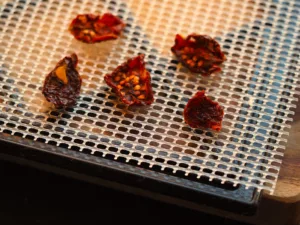
Tomatoes dried in electric dehydrator.
Electric Dehydrators
Electric dehydrators will work in all climates. These appliances come with user manuals that indicate drying times and temperatures for different types of foods. Electric dehydrators contain several mesh racks and are heated to 125°F to 140°F, depending on the produce. Drying time varies depending on the food, ranging from 3 to 18 hours.
Ovens
For those who don’t wish to invest in a separate piece of equipment, an oven can also be used to dehydrate when set at 140°F, after first preheating it to 150°F. Drying times in ovens can take twice as long as in electric dehydrators.
Tips for Dehydrating Vegetables
Keeping in mind that the intention of this article is to provide you with an overview of dehydrating homegrown produce rather than a complete guide, here are some tips to help you transform your homegrown bounty into long storing staples:
-
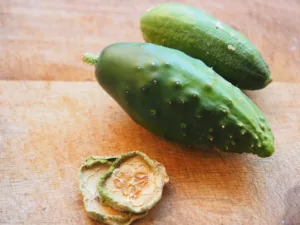
Cucumbers should be dried until brittle.
Choose produce that is at the perfect ripeness, and prepare it for drying as soon as possible after picking by cleaning it and wiping it dry.
- Remove any blemishes, peels, or seeds that you don’t want to eat later.
- Slice produce into uniform pieces, usually between 1/8 to 1/2 of an inch in thickness.
- With the exception of okra, peppers, garlic, and onions, blanching vegetables prior to drying improves color and taste in the dried product.
- Lay slices out in a single layer, and don’t crowd them in order to keep air circulating.
- While fruits (such as tomatoes) are dried until they are leathery, vegetables need further processing and are dehydrated until brittle.
- Dehydrated vegetables will not taste “cooked” unless you cook them either before or after drying. So, if you want dried staples for instant meals, cook the produce in boiling water prior to dehydrating.
- Allow fully dried produce to cool before packaging in airtight containers and storing in a cool, dark location. Adding moisture absorbers to containers is a great idea and can extend shelf life.
- Properly prepared dehydrated produce can last 12 months or more.
Produce preserved through this method can be enjoyed as a crispy snack. It can also be blended into a powder and used as a flavorful cooking ingredient. And of course, it can also be rehydrated and used in soups, pasta sauces, and other culinary creations.
The Square Foot Gardening Method is such an efficient way of growing food that abundant harvests are no rare thing, making this food preservation skill a must!

